

This is a simple and practical stone bladed tool. The original Hoko knife was found at an archaeological site in western Washington near the Hoko River where a native village was snuffed out by a landslide about 2700 years ago, well before any contact with Europeans. Among the artifacts found there was a very simple knife consisting of a very small, sharp stone flake hafted in a split cedar handle which was tied together with spruce root.
Pictures of the original can be seen in "Exploring Washington Archaeology", Ruth Kirk with Richard Daugherty, ISBN 0-295-95610-0.
Over several years of making and teaching people from 9-years-old to adult how to make Hoko knives I have developed several variations. First, cedar and spruce root aren't available where we live (San Francisco Bay area), so consequently we have used green willow (Salix sp.), coastal live oak (Quercus agrifolia) or California bay (Umbellularia California) for the handle and green willow bark or two-ply twined cordage made from dogbane (Apocynum sp.), shredded cattail leaf (Typha sp.), rawhide or anything else you can twine for binding the handle.
Material for the stone cutting blade does not need to be very
elegant. Something rough and strong such as basalt is the best
for cutting wood. Try to use flakes which have a long, straight
cutting edge and are not curved. A curved flake is more easily
broken when the handle clamps down on it.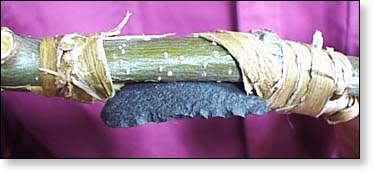
There are several variations on the original. If the handle is held together with only one binding then it makes it easy to change blades. Holding the handle on the side, which is not bound, makes the flake very secure.
Using the Hoko knife:
The original Hoko knives were quite small and delicate. The
handles were 5 inches (13 cm.) long and the blades were only thumbnail
size. The archaeologists who found them think that they were primarily
used for cutting fish, since the replicas which were tried out
for cutting basketry willow gave poor results. My opinion is that
the concept is sound, but a larger knife is more optimal for wood
working. Think of the Hoko knife as a saw or slicing tool.
This project provides valuable additional experience to students
in the following ways:
a. It provides a specific application for a piece of cordage.
It is difficult to teach people to make neat, strong cordage unless
they have a specific application in mind for the cordage.
b. Another previously made Hoko knife can be used to cut the
wood used for the handle, demonstrating the usefulness of the
tool.
A possible teaching sequence for a class in Stone Age survival
skills/technology might be:
1. Entire class helps twirl up a fire with a hand drill.
2. Hoko knife is shown to the students. Tell them that they
will make their own Hoko knives and use them to cut the notch
in the hearth board.
3. Students use sharp rocks to cut wood for handles.
4. Students make twined cordage for binding the handle.
5. Students knock off small flakes from a core to use as blades.
6. Knife is assembled.
7. Student uses knife to saw notch in fire-by-friction hearth
board.
Figures:




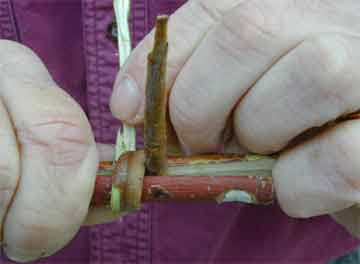
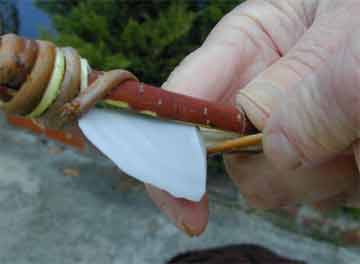
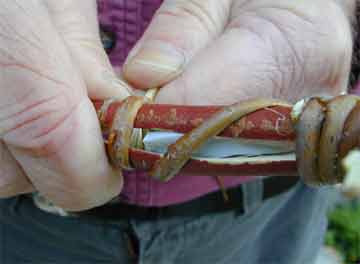
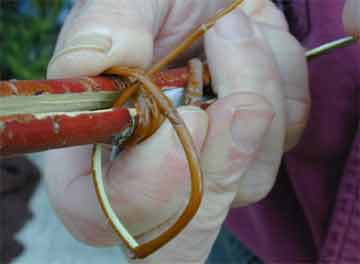


E-mail your comments to "Richard A. Baugh" at richardbaugh@att.net
We hope the information on the PrimitiveWays website is both instructional and enjoyable. Understand that no warranty or guarantee is included. We expect adults to act responsibly and children to be supervised by a responsible adult. If you use the information on this site to create your own projects or if you try techniques described on PrimitiveWays, behave in accordance with applicable laws, and think about the sustainability of natural resources. Using tools or techniques described on PrimitiveWays can be dangerous with exposure to heavy, sharp or pointed objects, fire, stone tools and hazards present in outdoor settings. Without proper care and caution, or if done incorrectly, there is a risk of property damage, personal injury or even death. So, be advised: Anyone using any information provided on the PrimitiveWays website assumes responsibility for using proper care and caution to protect property, the life, health and safety of himself or herself and all others. He or she expressly assumes all risk of harm or damage to all persons or property proximately caused by the use of this information.
© PrimitiveWays 2013